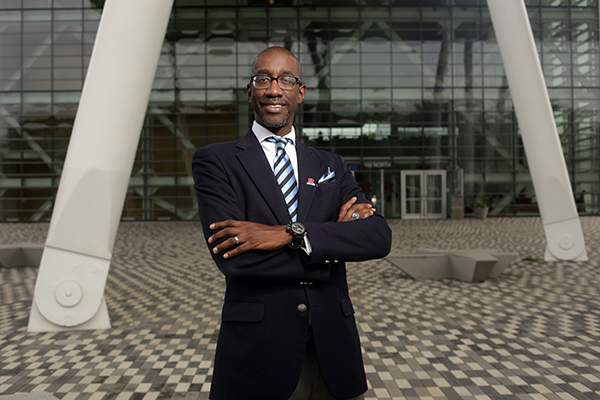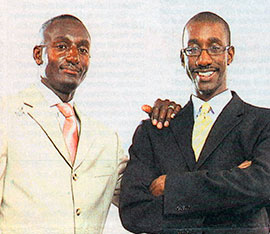( ENSPIRE Man Code 101 ) Scholars Dr. Randal Pinkett and Dr. Jeffrey Robinson Aspire to Share Entrepreneurial Advice for Black Professionals to Reach Success
ENSPIRE Contributor: Naomi Stamps
Scholars Dr. Randal Pinkett and Dr. Jeffrey Robinson recently released their business book “Black Faces in High Places” on February 8, 2022. It’s a sequel to their 2010 best-selling and award-winning book “Black Faces in White Places.” Their latest work, “Black Faces in High Places,” shares entrepreneurial advice and methods from Black entrepreneurs and executives. Some of the highlighted entrepreneurs include Oprah Winfrey, Cathy Hughes, President Barack, and First Lady Michelle Obama. They all share unique stories of how they reached the top and successfully stayed there.
“This book charts the path for those who are in the middle of their career or in the growth phase of their business or organization,” writes Pinkett and Robinson. “It is the culmination of many hours of research, and it draws on the life lessons and professional experiences of Black women and men who have successfully made the climb to become a Black face in a high place.” These hard-working scholars share steps in their book on how to become distinguished leaders. Besides this, they educate readers on the challenges they’ll face and how to conquer them all. Despite the constant struggles people of color endure, it’s inspiring that Pinkett and Robinson share their knowledge to show that success is obtainable.

Besides being best-selling authors, these scholars have many achievements under their belts. Pinkett is an entrepreneur with an influential voice in technology, inclusion, diversity, and business. He’s the co-founder, chairman, and CEO of a multimillion-dollar firm called BCT Partners. This company’s mission is to “provide insights about diverse people that lead to equity.” It’s been recognized by Forbes as one of America’s Best Management Consulting Firms and Pinkett has won many awards including the National Urban League’s Business Excellence Award. Besides this, he has earned five degrees and is passionate about giving back to the community.
Robinson is also the co-founder of BCT Partners and an award-winning business professor. He’s been a faculty member at Rutgers Business School, where he’s an assistant professor of management and entrepreneurship. Similar to Pinkett, this scholar has also obtained five degrees successfully. Besides producing written works about community and economic development issues, he operates the Jeffrey A Robinson International LLC consulting firm as the President and CEO. He’s also a dedicated advocate who’s involved in various organizations. Some organizations include the Sphinx Scholarship Fund and the Support Center for Non-Profit Management. This scholar is passionate about educating and encouraging others to be their best.

ENSPIRE spoke with Dr. Pinkett and Dr. Robinson about their new book.
How did you both come up with the idea for “Black Faces in High Places” and why do you feel it’s necessary?
Black Faces in High Places is a sequel to our first book together, Black Faces in White Places. We released our first book in 2010. It was focused on how Black professionals can navigate environments where we are still underrepresented without losing a sense of who they are. It was the intermediate course for Black professionals. We took a ten-year hiatus before we contemplated writing a second book.
In 2020, George Floyd’s murder sparked a great many conversations about the challenges still facing Black people. That same year, the COVID-19 pandemic heightened awareness around disparities and inequities still persistent in the Black community. Both led to societal shifts that further illuminated the importance of Black leadership, so we felt it was a good time to revisit and expand upon the themes in our first book, Black Faces in White Places. Black Faces in High Places is focused on how Black professionals can reach the top of their organization, industry, or field and stay there. It is the advanced course for Black professionals who aspire to become Black leaders.
How did each of you contribute to the making of this book?
We have both worked for established organizations and we have both created and grown our own enterprises, including the company we co-founded, BCT Partners. So, we both write from experience as both intrapreneurs and entrepreneurs. Once we jointly conceptualized the major themes for the book and each chapter, we divided and conquered.
Certain topics or chapters naturally lent themselves to one of our respective areas of expertise, which allowed us to each assume responsibility for generating the first drafts of specific chapters. We would then review, edit, and provide feedback on each other’s writing and keep refining the chapters until we were both comfortable with the finished product.
Can each of you tell us what’s your favorite chapter from “Black Faces in High Places?”
The book is organized into the 10 strategic actions for Black professionals to reach the top and stay there.
Dr. Pinkett: My favorite is Strategic Action 9: Transform Systems. This chapter is focused on how to scale up efforts leading to social and economic impact. For business leaders and entrepreneurs, it illustrates how to expand your market share and grow your enterprise. For nonprofit and philanthropic leaders, it offers insight into how to address societal issues.
For government, faith-based, and community-based leaders, to paints a picture for how to serve larger constituencies. And across all leaders, it provides practical models for how this can be accomplished such as strategic partnerships, joint ventures, mergers, and acquisitions. The basic premise of the chapter is not that 1+1=2, or 1+1=3, but rather, 1+1=100, or 1+1=1000, or more.
Dr. Robinson: My favorites are Strategic Action 7: Think and Act Like an Intrapreneur and Strategic Action 8: Think and Act Like an Entrepreneur. I combine them because they describe different sides of the same coin yet share the same underlying mindset: the entrepreneur’s mindset. We define the entrepreneur’s mindset as being comprised of five characteristics: creativity, resourcefulness, courage, resilience, and passion.
Intrapreneurs apply this mindset to established organizations, while entrepreneurs apply this mindset to create new organizations. Strategic Action 7 describes the specific steps intrapreneurs should take in the early, mid-, and late stages of their careers as it relates to developing self-mastery, finding meaning, networking, building power, and mentoring. Strategic Action 8 describes the key ingredients to growing a business venture from the perspective of marketing, management, money (i.e., capital), and more.
How can we encourage diversity in the business world?
To encourage diversity, equity, and inclusion (DEI) in the business world, we have to engage people’s heads, hearts, and hands. We engage their heads by making the business case for DEI, which clearly demonstrates its value including winning the war for talent, strengthening customer orientation, increasing employee satisfaction and engagement, improving decision making, fostering innovation, enhancing the company’s image, and improving the financial bottom line.
We engage people’s hearts by recognizing that DEI is not only the business thing to do, but also the right thing to do in order to help people feel a sense of inclusion and belonging. We engage people’s hands by giving them the tools to strengthen their DEI muscle and build their organization’s DEI capacity. This is particularly effective when proper incentives are put in place such as tying compensation to meeting DEI objectives and goals.
Dr. Pinkett, you were the first Black winner on the reality show “The Apprentice.” What was that experience like and what were some key takeaways?
My experience on “The Apprentice” was wonderful. I enjoyed the filming of the show, I enjoyed the competition of the show, I certainly enjoyed winning the show, and I was very excited to return back to my company, BCT Partners, complete my apprenticeship and continue the work we had started. Today, BCT has been recognized by Forbes as one of America’s Best Management Consulting Firms, Ernst & Young as EY Entrepreneur of the Year, Manage HR Magazine as a Top 10 Firm for Diversity & Inclusion, CIO Techie as one of the Most Trusted Government Technology Firms, the Black Enterprise BE 100s list of the nation’s largest African American-owned businesses and the Inc. 5000 list of the fastest-growing private companies in America!
There were two key takeaways from my experience. First, I learned first-hand the importance of being grounded in a set of values that honor diversity, equity, inclusion, fairness, honesty, integrity, and mutual loyalty. These are among the values that I uphold. Second, I learned that there is a right and a wrong way to succeed. It’s not just what you accomplish but how you accomplish it. I do not believe you have to step on others in order to step up. I believe we can all rise together. I do not believe that business is a zero-sum game where more of the pie for me is less of the pie for someone else. I believe we can all make the pie bigger. This is how I choose to conduct business and this is how me and my business partners at BCT Partners, Dr. Robinson, Lawrence Hibbert, and Dallas Grundy, proudly operate.
Are there any business books or podcasts you would recommend?
There are several books that inspired Black Faces in High Places, including the following:
- Success Runs in Our Race by George Fraser
- The Rage of a Privileged Class by Ellis Cose
- How to Succeed in Business Without Being White by Earl Graves
- The Seven Habits of Highly Effective People by Stephen R. Covey
- Why Should White Guys Have All the Fun by Reginald F. Lewis and Blair S. Walker
- The Making of Minority Executives by David Thomas and John Gabarro
- The Purpose-Driven Life by Rick Warren
Three other business books we recommend are:
- Blue Ocean Strategy by W. Chan Kim and Renée Mauborgne
- Good to Great by Jim Collins
- Traction by Geno Wickman
Dr. Robinson, you’re a strong advocate who’s involved in many community organizations. How do you define the success of your contributions?
I have been asked to define success many times. By comparison, I am far less frequently asked to define significance. My definitions are simple: Success represents what you do for yourself, whereas significance represents what you do for somebody else. Success is making a difference in your life, while significance is making a difference in the lives of others. Success is finite, it is momentary, it is discrete. It is a determination that is made at a particular point in time. For example, you can be successful in writing a business plan, or successful in launching a business, or successful in making lots of money. Significance is infinite, it is lasting, and it is limitless. By societal standards, not everyone will necessarily be successful in their lifetime, but everyone has the potential to be significant.
In honor of Black History Month, can each of you tell us one person you feel should be highlighted? It can be someone from the past or present.
Dr. Pinkett: I would highlight Reginald F. Lewis, an entrepreneur, business titan, and philanthropist. My mom gifted me his autobiography, Why Should White Guys Have All the Fun: How Reginald Lewis Created a Billion-Dollar Enterprise, as I was preparing to depart for Oxford University in England. Upon my arrival in the United Kingdom, I read the book in a single day. Lewis was a pioneer who orchestrated a leveraged buyout of the Beatrice company to become the first African American to run a billion-dollar company, TLC Beatrice (The Lewis Company). In 1993, Forbes listed Lewis among the 400 richest Americans, with a net worth estimated at $1 billion. At its peak in 1996, TLC Beatrice International Holdings Inc. had sales of $2.2 billion and was number 512 on Fortune magazine’s list of 1,000 largest companies.
Dr. Robinson: I would highlight Dr. Jessica Watkins, an Astronaut, and expert in geology. Talk about Black faces in high places … when she lifts off in April, Dr. Watkins will be the first Black woman to be on board the International Space Station! Dr. Watkins represents the contributions of many Black scientists, technologists, engineers, and mathematicians that have made this space travel possible. Not only is she brilliant, but she must be brave as well! She is part of the NASA Artemis Mission which will live on the moon beginning in 2024. She is the future of STEM and one of the diverse faces of space exploration that demonstrate that Black history is still being made today!

Since people of color are constantly limited, Pinkett and Robinson are dedicated to helping them reach their full potential. As racism continues to rear its ugly head, it’s easy for others to get discouraged and doubt their capabilities. With “Black Faces in High Places,” these scholars want to change this mindset by sharing success stories and words of advice. Pinkett and Robinson show us that true success is when we’re willing to help others. While it’s always good to build up your own credentials, you should never refrain from sharing your journey with others. We can only move forward if we work together.
Purchase the book here or on Amazon.
Follow Dr. Pinkett on Facebook.
Follow Dr. Robinson on Twitter.
Another article you might enjoy: Entrepreneur Armond Davis Provides Funding for Minority Businesses







